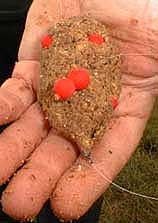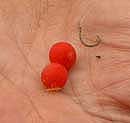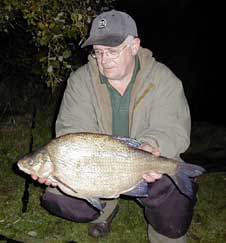 I can’t remember the exact history of it, but just a few years ago someone was fishing for pasties (small carp) with a conventional open-end swimfeeder and couldn’t hit many bites. The trouble was, he was getting so many bites it was frustrating the hell out of him. He tried everything; longer hooklengths, shorter hooklengths, smaller hooks and smaller baits, bigger hooks and bigger baits. You name it, he tried it, but nothing made any difference. So he decided that the fish must be attacking the feeder rather than the hookbait, so what he did next was cast in without a hookbait. The feeder was filled normally but the hook was bare. Sure enough, the quiver-tip still rattled round like a good ‘un.
I can’t remember the exact history of it, but just a few years ago someone was fishing for pasties (small carp) with a conventional open-end swimfeeder and couldn’t hit many bites. The trouble was, he was getting so many bites it was frustrating the hell out of him. He tried everything; longer hooklengths, shorter hooklengths, smaller hooks and smaller baits, bigger hooks and bigger baits. You name it, he tried it, but nothing made any difference. So he decided that the fish must be attacking the feeder rather than the hookbait, so what he did next was cast in without a hookbait. The feeder was filled normally but the hook was bare. Sure enough, the quiver-tip still rattled round like a good ‘un.
So what he did next was bait the hook and stick the hooklength inside the feeder so that the hookbait was just, and only just, poking out of the end. He thought that if the fish were so set on ridding out the contents of the feeder then inside the feeder, almost, was the best place for the hookbait. It was, and the rest is history.
The method became known as ‘The Method’. THE Method, because it went from strength to strength to become responsible for some really big match and pleasure catches, and those in the know kept it very quiet for quite some time.
 Since the Method has become widely known and very popular it has of course been greatly improved upon since those early days when it was developed with a conventional open-end swimfeeder. Today we have specially manufactured method feeders and the technique has been developed into a fine art.
Since the Method has become widely known and very popular it has of course been greatly improved upon since those early days when it was developed with a conventional open-end swimfeeder. Today we have specially manufactured method feeders and the technique has been developed into a fine art.
Like any technique, however, the Method is not the answer to every swimfeeder fishing situation. It is only effective when fished in the right circumstances. Ideally, the right time for the Method is usually when there are a lot of fish competing for the available food and eagerly attacking the feeder. Overstocked carp fisheries, pastie waters, are made for it. But other waters and other species can, and do, fall to the Method. Only recently I caught double-figure bream and some nice carp and tench using the Method.
There are quite a few different styles of Method feeder, some incorporating power gum, some with wire coils, etc. But my favourite is the Richworth type which can be seen in the pictures. Maybe the coiled wire and other types are better for smaller fish, but the Richworth one does it for me for the bigger fish.
 Setting it up is simple, for I use it as a safety bolt-rig. You thread the main line through the feeder, thread a one inch silicon tube on the line and then tie on a swivel. The silicon tube fits tightly onto the plastic tube at the bottom of the feeder and also fits onto the swivel, holding the two together, but able to release easily if the line should break with a fish attached.
Setting it up is simple, for I use it as a safety bolt-rig. You thread the main line through the feeder, thread a one inch silicon tube on the line and then tie on a swivel. The silicon tube fits tightly onto the plastic tube at the bottom of the feeder and also fits onto the swivel, holding the two together, but able to release easily if the line should break with a fish attached.
The strength of main line you use obviously depends on the size of fish you expect to catch, with 6lb being a minimum due to the heavy weight of the feeder when loaded. I generally use 8lb for bream, smaller carp and tench and 10lb to 12lb when fishing for bigger carp. Again, hooklength strength is according to size of fish. I use 6lb to 8lb for bream, smaller carp and tench, and 10lb to 12lb for bigger carp. You can use any kind of hooklength material you like, either braid or mono, but my favourite for the Method is most definitely fluorocarbon mono. Apart from its invisibility quality it is incredibly smooth and very slightly stiff, and I think all those qualities are important when fishing the Method. The advantage of invisibility is obvious. The advantage of smoothness is that it does less than rougher lines to spook the fish during the initial pick-up, and the slight stiffness helps the anti-eject effect.
The hooklength should be much shorter than normal, 4 to 6 inches being about right, but when fishing for big bream 6 to 9 inches is my preference.
When using smaller baits like maggot and caster you can hook direct to a 16, 14 or 12 , but with anything bigger it is better to hair-rig. Sweetcorn, nuts, paste, meat, cheese, pellets and boilies are all better hair-rigged.
 When the hair is loaded with bait the groundbait is clamped round the feeder, tight enough to hold according to the effort needed to cast the distance being fished, but not too tight it will take too long to break up when in the water. Then the hook is pushed into the groundbait, leaving the bait on the outside. The idea is to make the hookbait part of the groundbait package, but one of the most easily accessible morsels. Popped-up baits do work, but sinkers are better, for you want the hookbait to stay with the groundbait, not to float above it when the hook comes free from the groundbait shortly after casting.
When the hair is loaded with bait the groundbait is clamped round the feeder, tight enough to hold according to the effort needed to cast the distance being fished, but not too tight it will take too long to break up when in the water. Then the hook is pushed into the groundbait, leaving the bait on the outside. The idea is to make the hookbait part of the groundbait package, but one of the most easily accessible morsels. Popped-up baits do work, but sinkers are better, for you want the hookbait to stay with the groundbait, not to float above it when the hook comes free from the groundbait shortly after casting.
You can fish with any kind of indicator set-up, but whatever you use, ignore any but the most obvious bites, for many of them will be due to the feeder being moved and knocked about.
Cast fairly regularly, but as with all types of feeder fishing, be accurate. You don’t want dollops of groundbait dotted all over the place. The idea, as always, is to attract the fish to one area and not spread them hither and thither. Also, you need to cast regularly so that the groundbait package upon which your hookbait sits is not broken down too much and covering too large an area.
Finally, make sure you use a proper Method feeder groundbait mix. If it’s not then there is a danger that it won’t be sticky enough and will fall off the feeder when in flight, or too soon after it hits the water. The groundbait needs to stick to the feeder until it hits the bottom of the lake. The other danger of a wrong mix is that it will be too sticky and clamped around the feeder long after the cast and not making it easy for the fish to get at the hookbait. Such a groundbait will also come away in solid lumps and tend to overfeed the fish.
My favourite, obviously, is my own mix in the Marden’s Magic range, the Method Mix, which is available from the Mr Wriggles stable. This was developed this year and has accounted for some big catches of big bream, tench and carp. It is a potent blend of quality fish meals, ground pellets, essential oils, appetite stimulators, selected particles, all held together with an exclusive binder. The price compares very favourably with higher profile but inferior products too.
If you fancy trying it drop an e-mail to Dave Dowding at Mr Wriggles and he’ll send you all the details of all the Marsden’s Magic range and his other range of quality baits and products.












